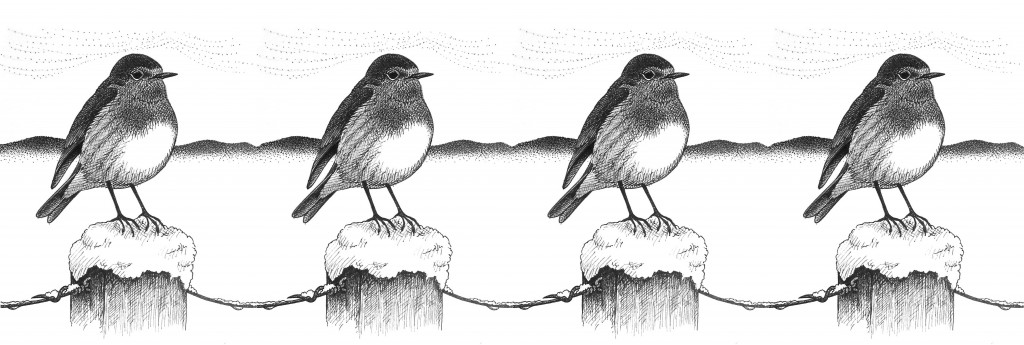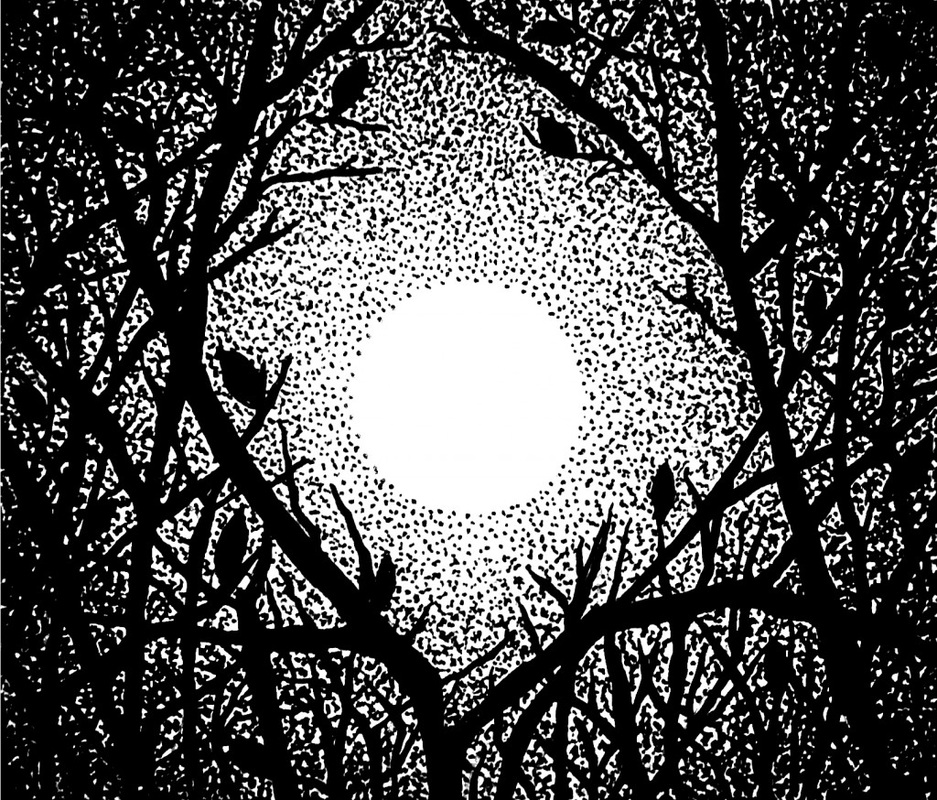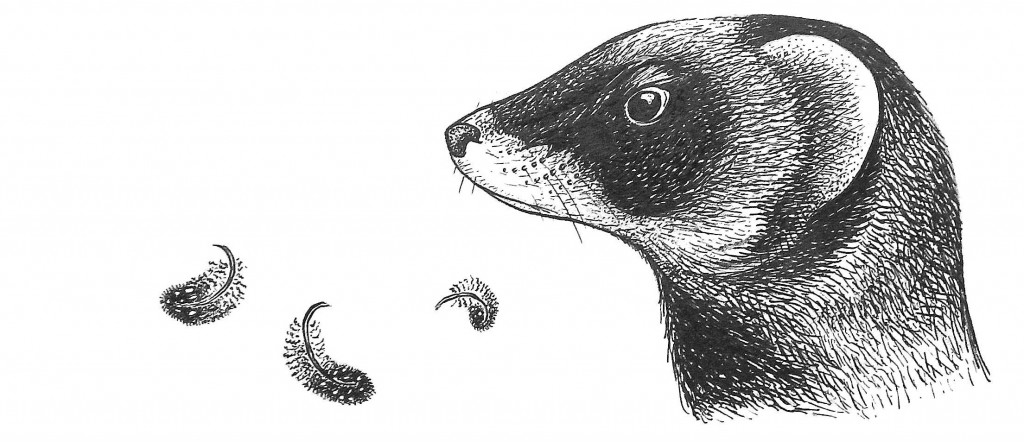|
The bird lands in the willow just outside the dining room. Or at least, the bird appears in the willow. I do not see it land. One moment I am reading beside the window and there is no bird. The next I have stopped reading.
It stands on a thin branch, somewhere close to the centre of the tree. Cocked, its slim tail twitches up and down, not quite rhythmically. Each movement is sudden and convulsive. It looks about, then bows, dipping and lifting its head in an instant. Then it calls: a single, high-pitched chkk. It calls again: chkk-chkk. With each sound, the tail jerks, steadying the bird and keeping it from capsizing. It bows further, wipes its tiny beak on the branch – one side then the other – turns and calls again. Shifting direction gradually, it shouts a wall around the garden, then pauses, waiting for a challenge. There is an unmistakable hint of arrogance in its stance – the head is held high, the orange-red breast is plumped up and puffed out defiantly. “This is my place”, it seems to say. “I live here.” There are few birds so widely recognised or so well loved as the robin. There are few birds, too, so emblematic of one particular time or season. For though it is a year-round British resident, the robin is most fondly thought of as a winter bird. Here in Shetland that is even more true than elsewhere. Only a tiny number of robins, if any, actually breed in the islands, but from late autumn those few residents are joined by an influx of migrants from Scandinavia. Some of these birds will stay only briefly, but others remain until spring. Winter is their season. Robins appeal to that part of us that is beguiled by simple things: bright colours, funny walks, amusing characteristics. We enjoy them because they catch our eye, and in doing so invoke some kind of strange empathy. A dead robin on the doorstep somehow seems more tragic than a dead sparrow. This feeling is all the more peculiar since we face a problem when looking at birds: how do we separate the individual from the general? I can sit and watch this robin outside my window for five minutes, ten minutes, half an hour. I can describe its behaviour, and note down the details of its appearance – the sweet red-orange of its breast, neck and forehead; the grey outline of its face; the flash of white belly; the nervous posture. But this picture will always be lacking. When the bird flies and I am left only with my words, they seem no more specific than the illustrations in my guide book or on my Christmas cards. Robins on garden gates. Robins on fence posts. Robins on snow-draped branches, flanked by mistletoe. Is it possible to tease out one bird from these dense layers of images? Can we understand this single robin without reducing it to the generic one that each of us carries in memory and imagination? For the most part, our understanding of individuality is tied up with intelligence. The difference between looking at a robin and looking at a raven, say, is that while the larger bird may see its world quite differently from the way that we see ours, the raven’s gaze is nonetheless recognisable. There is something like thought going on behind those eyes; and where there is thought, there is personality. In the robin, I do not see thought; I see only an indecipherable code of action and reaction. So what, then, is a robin? What is this tiny creature that stands and sings and flies and feeds? The truth is that, amputated from its perch, that robin may be less than we imagine. Written or drawn from the tree onto the page, the bird becomes something other than what it is. For what it is, to some extent, is there in that tree. Barry Lopez once wrote that an ‘animal’s environment, the background against which we see it, can be rendered as something like the animal itself – partly unchartable. And to try to understand the animal apart from its background, except as an imaginative exercise, is to risk the collapse of both. To be what they are they require each other.’ This bird, like all birds, like all living things, is defined by its context – by its place. While it is here, the robin is part of the garden and the garden is part of the robin. Both are entwined in a way that reaches beyond observation and certainly beyond description. It is a relationship that goes to the heart of what it means to be at home. For a time the bird is gone, somewhere unseen, though I continue to watch the branch where it had stood. A few minutes later it returns and begins to call again: chkk-chkk. The robin’s little tail lifts and falls; it wipes its beak; it looks around; it calls again; it flies. I return to my book. As the year gets older, darkness fills more and more of the day. Right now, the sun rises at eight o’clock in the morning and sets again about half past three in the afternoon, though even between these hours daylight can sometimes seem pallid and weak, infected with a kind of grim lethargy that fails ever to lift itself out of the shadows. By late December, another ninety minutes or so will have disappeared into the night.
Between three and four o’clock in the afternoon, as the air pales and the trees blacken against the sky, I have taken to standing outside for a moment to listen as a frantic dusk chorus sharpens the soft edges of the day. At first it is the crows that come, wheeling in from around the valley and calling as they settle down among the branches. Then, from every direction, scores of thrushes – mostly blackbirds, with redwings and fieldfares among them. Silhouetted in the murky light, the birds arrive, flapping impatiently into the safety of the garden. The sound of them lifts from the trees like rowdy restaurant chatter. One evening , amid that glorious din, an owl ghosted silently above me and then was gone, as though it might never have existed at all. From four o’clock, night thickens and the world closes around us. To be outside is to be somewhere new, in which we humans are rather improperly equipped. A torch now sits beside the front door to compensate for this inadequacy, and to make journeys to and from the house somewhat less hazardous. The electric beam opens a narrow space in which we can move without impediment and pretend to ourselves that we are not out of place in this nocturnal world. Yet even at this time of year there are nights when, lit by moon or stars, the claustrophobic blackness is lifted and the universe is suddenly bigger than ever it is in the day. Tonight, on my way back from the shed with a basket of wood for the fire, I stopped on the grass beside the greenhouse and stood still. Facing east, I could see lights from the houses across the valley shining like earthbound constellations against the darkness of the hill. Above them, the moon glowed brightly, highlighting the grey smudges upon its surface. Two days past full, only a slight fuzz at the right edge blemished an otherwise perfect circle. Between earth and moon, a long thin cloud stretched out like a swimming seal, with a smaller partner following close behind. Besides these, the sky was clear and pale, infused with a colour quite unlike anything ever seen in the daytime. It was, perhaps, like the deepest blue silk held up against a dimly lit window, permitting only a thin blush of light to penetrate. But it was not really like that at all. Around me, the garden was lit up enough to find my way without fear of mishap, enough to read back these notes as I scribbled them, childlike, across the page. It was bright enough that, standing there, I cast a long shadow over the lawn (suddenly I imagined Cat Stevens singing, entirely against my will). In the night time, sounds untangle and identify themselves in a way not required at other times. And even then, in that strange light, I could hear what might go unheard in the day. There was the loch lapping against the bank below the trees; the purr of a wind turbine turning just up the road; the bustle and thrum of wings among the branches; and though it was almost calm, there was the white noise of water and air moving in the same direction that is the constant background to life this close to the sea. As I turned towards the house, a shooting star blazed for an instant above me. Always they seem to move at the edge of vision, and are gone so fast that, like the owl, I can hardly be sure they were ever there at all. Looking up, tiny sparks were rising from our newly-swept chimney, glittering golden yellow as they danced and faded in the night. Each evening, when the hens have retired to their house, one of us must go and close the door behind them. The birds are entirely free range, roaming around the garden, kicking up mud and leaves in the flower beds, picking their way methodically through the lawns. They make a mess, but for now it is tolerable, and they do pay their way in kind.
When it reaches a certain time of day – or more specifically a certain level of light – the hens cease their wandering and head home to one of our sheds, which is accessed by a hole in the wall, with a ramp both inside and out. Once they’re in, it is up to us to close the door. Tonight, on my way out to a meeting in Lerwick, I did just that – lowered the little wooden door and fixed it in place. Then I looked inside the shed to make sure there was food and water, and to see that everything was okay. Everything was not okay. We have – or had – three hens, all Rhode Island Reds, with subtle differences in colour, character and social status. The lowest ranking of these was also the tamest, with one characteristic perhaps compensating slightly for the other. She was, in addition, a layer of enormous eggs. Recently though, this particular bird had adopted a bad habit of roosting on the ramp just inside the entranceway rather than jumping up to the perch alongside the others, and it was almost certainly this habit that cost her her life, for when I arrived in the henhouse she was lying beside the door, virtually intact but unquestionably dead. At the back of the coop, now deprived of an escape route, was the foul-smelling culprit. There are no native land mammals in Shetland but several have been introduced over the centuries and have made the islands their home: house and field mice (which have been here long enough to evolve into sub-species), otters, rats, hedgehogs, rabbits, mountain hares, stoats and, undoubtedly the least popular of all, polecat-ferrets. This hybrid, with its familiar robber-mask markings, only appeared here about 30 years ago. Whether first released deliberately or accidentally is unclear, but they bred and now thrive, eating rabbits, wild birds, eggs and just about anything else they can find. Given the chance they will also eat hens, and once inside a henhouse they will often as not kill everything. This particular individual was interrupted in its task by my arrival, which was lucky for me and for the two remaining hens, but considerably less so for the polecat-ferret. Standing on its back legs in the corner of the shed, it was looking for a way out. My choices were limited. If I opened the door and let it go, there was little doubt it would be back the following night to finish the job. As I had no interest in losing any more hens, I could not let it go. Not for the first time, I regretted not owning a gun. The chicken wire that separated me from the polecat was reassuring. While it was alive and still capable of biting me I would have preferred to stay separated; but that wasn’t going to be possible. The only solution I could see was the shovel leaning up against the wall, and that was a long way from ideal. I picked it up reluctantly and the decision was made. The temporary stalemate within the henhouse was immediately broken when I undid the latch and stepped through the gate. One of the birds, which had so far been as still and quiet as if they had been sleeping, saw in that instant an opportunity to escape. In a flash of feathers she leapt over my shoulder and out of the shed door, squawking all the way. Her companion, now more terrified than ever, just sat still, her eyes fixed on me, then on the floor, then on the shovel. In the time it took for the first hen to flee, the polecat-ferret had moved from the back wall towards the hatch, and finding it closed had curled up in the narrow entranceway, putting itself almost out of reach. It is at moments like these that we see things that may not be there: complex thoughts and emotions in an animal whose face we cannot truly read. At moments like these we see a kind of distorted mirror, where the muddle inside of us is reflected in the eyes of another creature. I did not see fear in the polecat, nor aggression. Though it must have experienced some kind of anxiety, the hopelessness of its situation – trapped in a cage with nowhere to go – seemed to bring out something more complicated and unnerving. A strange kind of resignation was what I saw: an absence of panic. The polecat seemed calm, as though it understood, in a way that it could not possibly have done, that the game was definitely up. When I swung the shovel against the wall to try and dislodge the animal from the entranceway, the polecat didn’t bolt as I’d expected. It unfurled itself out into the coop, then walked slowly back to the far corner, where it stopped still and waited. I lifted the shovel again. When it was done, I removed both bodies – bird and animal – and laid them in a cardboard box to deal with in the morning. I stayed with the one remaining hen for a few moments, waiting for her to calm down again and for quiet to return, then I switched off the light and flicked my torch back on. I had long since missed my meeting in town. I wondered then how I would feel if this creature were native. Had it not been a recently-introduced pest – a threat to both wild and domestic birds – could I defend my actions so easily? After all, were it to speak, the animal might quite justifiably say to me: “I was here first”. The polecat doesn’t need to talk, of course. I know the questions, and I know that my answers do not entirely release me from hypocrisy. But I do not feel guilty. As I came back down the path towards the house, I saw that our cat had found a juvenile blackbird and was waiting for a chance to finish it off. The bird was flapping against the windows and walls, unable to lift itself high enough to be free. I picked it up and chased the cat away, then held my arm in the air. The blackbird opened its wings and vanished into the night. |
The Things Around MeThe Things Around Me is the story of a Shetland garden, written by Malachy Tallack and illustrated by Will Miles.
Archives
October 2016
|



 RSS Feed
RSS Feed